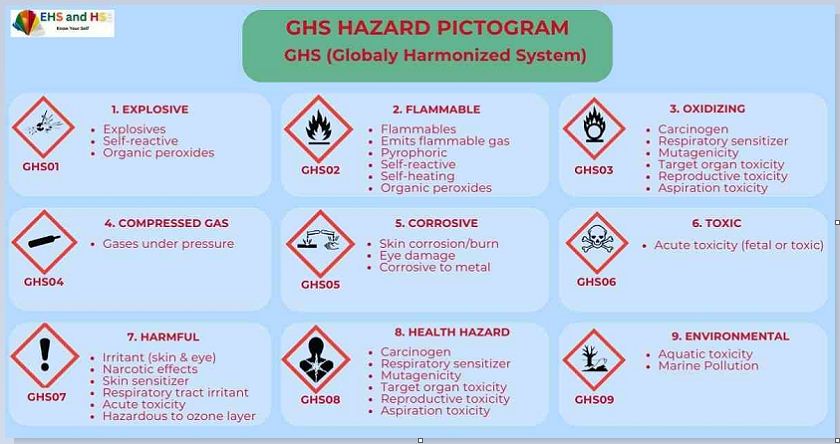GHS (Globally Harmonised System)
The GHS classification process uses defined criteria to identify the hazard of a chemical or mixture by assigning a hazard sign which is called a GHS hazard pictogram. Here is the detail for Understanding GHS Hazard Pictograms and Their Meanings.
The GHS hazard pictogram defines 9 types of hazards in this pictogram. These hazards have specific signs to define this hazard. Quick and simple to understand the hazards of chemicals, the related signs show the hazard.
Scope of GHS hazard pictogam
Hazards defined in GHS hazard
1. health hazard.
2. Flammable.
3. Harmful.
4. Compressed gas
5. Corrosive
6. Explosive
7. Environmental hazard
8. Toxic/Poison
9. Oxidizing
GHS Hazard Pictogaram
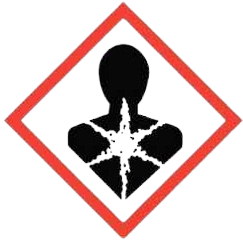
1. health hazard.
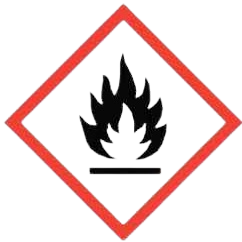
2. Flammable.

3. Harmful.

4. Compressed gas
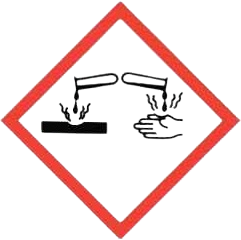
5. Corrosive

6. Explosive

7. Environmental
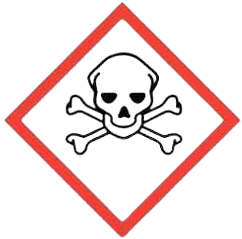
8. Toxic
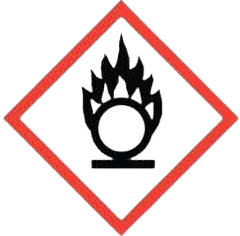
9. Oxidizing
1. HEALTH HAZARD
Carcinogen: substance, organism, or agent capable of causing cancer.
Respiratory sensitizer: a substance that will induce hypersensitivity of the airways following inhalation.
Mutagenicity: used to describe the property of chemical agents or drug substances to induce genetic mutation.
Target organ toxicity: chemicals that cause adverse effects or disease states manifested in specific organs of the body.
Reproductive toxicity: chemicals that may adversely affect human reproductive function, fetal development, and fertility.
Aspiration toxicity: it describes severe effects such as chemical pneumonia, varying degrees of pulmonary injury, or death.
2. FLAMMABLE
Flammables: A liquid with a flash point under 37.778°C is considered flammable
Emits flammable gas: within certain limits, it can react explosively.
Pyrophoric: substances and particles that ignite instantly upon exposure to oxygen.
Self-reactive: thermally unstable chemicals undergo a strong exothermic.
Self-heating: a process of gradual reaction of that substance or mixture with oxygen generates heat.
Organic peroxides: hydrogen peroxide, where one or both hydrogen molecules are replaced by organic “free radicals”.
3. HARMFUL
Irritant (skin & eye): chemicals that cause adverse changes in contact (skin, eye, mucous membrane, respiratory tract, etc) after a single exposure
Narcotic effects: use comes with a variety of unwanted effects, including drowsiness, apathy, and inability to concentrate.
Skin sensitizer: chemicals with the potential to cause allergic contact dermatitis.
Respiratory tract irritant: a chemical that can cause inflammation or other adverse reactions in the respiratory system
Acute toxicity: single, short-term exposure where effects appear immediately.
Hazardous to the ozone layer (harmful) (non-mandatory)
4. COMPRESSED GAS
Gases under pressure: gases that are contained in a receptacle (container) at a pressure of 200 kPa (kilopascals) or 29 psi (pounds square inch gauge).
5. CORROSIVE
Skin corrosion/burn: it creates irreversible damage to the skin.
Eye damage: has bad effects on the eyes and creates sensitivity.
Corrosive to metal: it can also damage metal for long-term use.
6. EXPLOSIVE
Explosives: under the influence of thermal or mechanical shock. It decomposes rapidly and spontaneously with the evolution of large amounts of heat and gas.
Self-reactive: thermally unstable chemicals undergo a strong exothermic.
Organic peroxides:
7. ENVIRONMENTAL
Aquatic toxicity: the effects of chemicals on organisms living in water.
8. TOXIC
Acute toxicity (fetal or toxic): short-term exposure where effects appear immediately and are often reversible.
9. OXIDIZING
Oxidizers: chemicals that react readily with most organic material or reducing agents without a power source.
The above-mentioned hazards of chemicals to understand the GHS hazards pictogram and their meanings.

